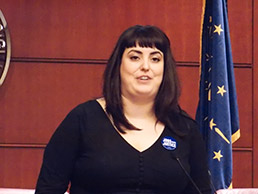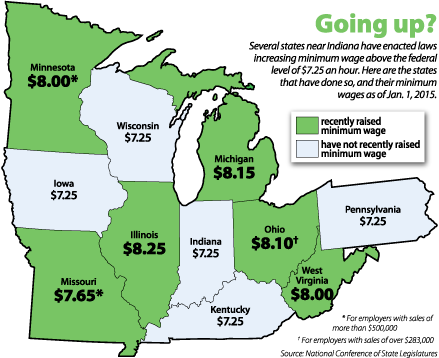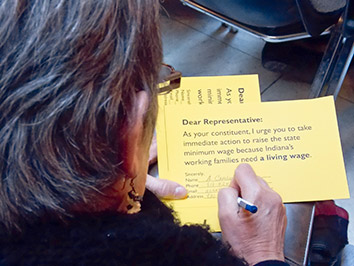Subscriber Benefit
As a subscriber you can listen to articles at work, in the car, or while you work out. Subscribe NowMore than half of states in the U.S. have enacted laws increasing their minimum wages above the federal standard of $7.25 an hour, but the Indiana Legislature won’t even discuss it.
“No,” Sen. Phil Boots replied when asked if he would schedule a hearing before the Senate Pensions & Labor Committee he chairs for either of two bills that would raise the wage. “It’s a free market, and I think people should be able to work for whatever they want to work for,” the Crawfordsville Republican said.
“It’s not for the government to get involved in, in my opinion,” Boots said.
With a supermajority of Republicans in the General Assembly, one Democratic bill sponsor acknowledged she’ll strike out at the committee level, but that doesn’t mean the proposal won’t come up during this session.
“It doesn’t mean you can’t force a vote on the issue, if we find a suitable place to put this as a second-reading amendment,” said Sen. Karen Tallian, D-Portage. “I’m looking, I’m watching. It could be a Senate bill, it could be a House bill.”
Tallian’s Senate Bill 41 would increase the minimum wage to $10.10 an hour. Senate Bill 160, authored by Sen. Frank Mrvan, D-Hammond, would raise the wage to $8.50 an hour in July, then to $10 an hour in 2016 for most workers.
 Tallian
Tallian“We’d have to be in the majority to get a hearing,” Tallian said of the proposals. “We need to have this discussion because our wages in the state of Indiana are low compared to a lot of areas, and there are a lot of reasons why the minimum wage should be increased.”
Mrvan said the minimum wage proposal should get a vote. “One of the reasons I’m encouraged is because it’s happening all over the United States,” he said.
While the state boasts a business-friendly environment, it ranks 39th in average income, Mrvan said. “That’s nothing to be proud of. … We should also be fair and help the workers.”
 Central Indiana Jobs with Justice Executive Director Mary Kate Dugan spoke at a recent forum at Indiana University Robert H. McKinney School of Law in which she advocated for a living wage. (IL Photo/Dave Stafford)
Central Indiana Jobs with Justice Executive Director Mary Kate Dugan spoke at a recent forum at Indiana University Robert H. McKinney School of Law in which she advocated for a living wage. (IL Photo/Dave Stafford)Proposals to raise the federal minimum wage have gone nowhere in Congress, but 29 states and the District of Columbia have acted on their own, increasing their minimum wages as of Jan. 1, 2015, according to the National Conference of State Legislatures. The current $7.25 federal minimum wage has been on the books since 2009.
All of Indiana’s neighboring states except Kentucky have increased the minimum wage, and one house of the Bluegrass State’s Legislature last year approved a raise. Louisville, meanwhile, has enacted a $9 minimum wage in the city.
 Boots
BootsBoots, though, sees proposals to increase the minimum wage representing government interference in the market that could harm the economy. “If we continue to drive up wages, all we do is increase the cost of everything, and nobody really benefits.
“It impacts so few people that it really doesn’t make that much of a difference,” he said.
The Bureau of Labor Statistics reported in 2012 that 3.6 million American workers were paid at or below the federal minimum wage, representing about 4.7 percent of all hourly paid workers. Most of these workers are employed in service, maintenance and health care support occupations.
But advocates of increasing the minimum wage to $10.10 say doing so would mean a raise for about 25 percent of Hoosier workers. No state currently has a minimum wage this high, however. Washington, D.C., will raise its minimum wage to $10.50 in July, and a handful of states will raise their minimum wages to $10 or more in the next two years.
At a recent forum at the Indiana University Robert H. McKinney School of Law advocating a living wage as a human right, representatives of labor and social justice organizations described the movement as fulfilling the visions of such leaders as President Franklin D. Roosevelt and Dr. Martin Luther King Jr.
Derek Thomas, senior policy analyst for the Indiana Institute for Working Families, said the think tank’s research concludes that the federal minimum wage is not enough for a single person to be self-sufficient in any Indiana County. On the low end, a wage of $7.75 an hour is required for self-sufficiency in Vermillion County. On the high end, the minimum hourly wage necessary for self-sufficiency in Hamilton County is $11.21.
Institute research says the 1968 minimum wage adjusted for inflation would be $10.96 in 2014 dollars. If the wage were indexed to Hoosier productivity, Thomas said the wage would be $19 an hour.
Panelists at the IU McKinney event included workers who earn minimum wage and say it’s simply not enough to pay the bills. Pamela Toney is a home health care worker who said she earns minimum wage after more than 30 years doing a job she feels called to do.
“Nobody should have to worry about making a living wage,” she said.
Mary Kate Dugan, executive director of Central Indiana Jobs with Justice, urged the IU McKinney audience to support Tallian’s bill. “We need to not let our state legislators off the hook,” she said.
Dugan downplayed concerns that red-state Indiana would reject increasing the minimum wage, noting that many of the states that have enacted raises are those with Republican leadership.
 She pointed to Michigan, where the Republican-controlled Legislature last year passed a bill signed into law by GOP Gov. Rick Snyder that gradually will raise the state’s minimum wage to $9.25 an hour in 2018. Afterward, the wage will be linked to the Consumer Price Index, with increases not to exceed 3.5 percent.
She pointed to Michigan, where the Republican-controlled Legislature last year passed a bill signed into law by GOP Gov. Rick Snyder that gradually will raise the state’s minimum wage to $9.25 an hour in 2018. Afterward, the wage will be linked to the Consumer Price Index, with increases not to exceed 3.5 percent.
Dugan said the bill passed in part to thwart a proposed ballot initiative that would have increased the minimum wage to $10.10 an hour. She noted that when Michigan state Rep. Peter Pettalia announced his support of the bill, he said he did so “because the alternative is terrible.”
“What this shows is, where we’re organized, we’re powerful,” Dugan said.
But a ballot initiative such as was proposed in Michigan isn’t available to Hoosier voters, and supporters say they’re hoping just to get the conversation started in Indiana.
Advocates carried their efforts from the law school to the Statehouse for a series of weekly rallies that also aimed to pressure individual lawmakers.
“Indiana has never been out front in pushing a minimum wage that is higher than the federal level,” Tallian said.
According to the fiscal impact statement for Tallian’s bill, it would cost the state an additional $2.5 million annually in salaries and benefits for state workers earning between $7.25 and $10.10 per hour. Local units of government would pay an extra $31 million per year for about 23,000 employees paid in this range. The state would raise an additional $813,000 in income tax revenue because of the increased earnings, and statewide local option income tax revenue would rise by an estimated $357,000.
The fiscal analysis did not examine private-sector costs or benefits and made no assumptions regarding the potential increase in sales tax collections based on higher earnings. Mrvan believes the benefits of increased earnings would outweigh the negatives.
“Whatever we pay extra, these people have to spend the money; they can’t hoard it,” he said.•
Please enable JavaScript to view this content.

